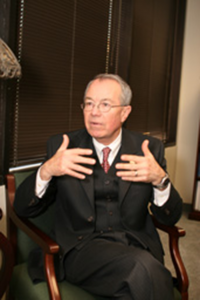By Shelly Williams/editor-in-chief

She came out of the brush and shot an arrow at the helicopter as if to say the primitive island off Sumatra was fine and it should go away.
No traces of a tsunami had landed there. The helicopter that had flown to check on the possible damage of the island flew away.
This is one of many anecdotes TCC interim vice chancellor of administration and communications services Bill Lace found while writing his non-fiction book The Indian Ocean Tsunami of 2004, published in 2008.
Since his first book on Nolan Ryan for elementary students in 1991, Lace has published an estimated 50 books in almost 20 years.
“I honestly never thought that I would be a published author. It was just one of those things, frankly, that my wife pushed me into,” Lace said.
“I’m delighted she did that. She was an elementary school librarian in Arlington. There hadn’t been a book on him [Ryan] since the ’70s.
“I’d been a sports writer for the Star-Telegram, and my wife said, ‘Why don’t you write a book on Nolan Ryan for kids this age?’ So the way things go, she kept asking and asking, and I finally agreed to give it a try pretty much so she wouldn’t ask me anymore. To my amazement, it was picked up and published in ’91 and came out in ’93.”
Lace said he has published books about social studies ranging from the Holocaust, Tiger Woods, the atomic bomb, anesthesia, ghost hunters and many more.
“What makes Bill an exceptional author is his ability to tell a great story,” said Lori Shein, a former co-worker and current managing editor for ReferencePoint Press.
“He manages to find fascinating details about the people and events he writes about and then weave them together into a story that readers want to read. And he accomplishes all of this within the realm of nonfiction.”
Lace said the hardest part about his most recent book was gathering and organizing the research information, especially because he struggled to find it. It took six months for his book to be completed.
“It was more difficult than I thought because, surprisingly, there weren’t very many books written on the tsunami. Maybe just a couple and a lot of them were mostly picture books,” Lace said. “But there were tons of newspaper and magazine articles that were available on the Internet.”
Toisan Craigg, fellow co-worker and part of the Chelsea House publication company that Lace currently writes for, said Lace often manages to recapture the attention of readers when it comes to topics that are frequently written on.
“I have enjoyed working with Bill for the two and a half years that I’ve been at Chelsea House,” Craigg said in an e-mail. “His books, Sir Francis Drake and Captain James Cook, are well-written, thoroughly researched and entertaining.
“He finds a means to interest and attract readers to oft-written-about subjects in a fresh and thrilling way.”
Lace said he works a lot of nights and weekends around his job when writing his books, but that the most memorable parts of illustrating the tsunami in written words were the stories he found while compiling his research.
“I think some of the stories of people surviving and the way they survived were my favorite,” Lace said.
“I think there was one man who was swept out to sea on a wooden raft, and he drifted around for a couple of weeks with just a little bit of water and somehow survived.”
Lace said aspiring writers who are interested in non-fiction books should read everything they can.
“I think one of the best ways to learn to write is to read a lot,” he said.
“With reading, you sort of instinctively put together how sentences are put together, how paragraphs are put together. The second thing would be to broaden your interest.
“Read a newspaper everyday, maybe more than one. With the Internet, you can read anything you want to read.”
Lace has had several books released since The Indian Ocean Tsunami of 2004 and is currently working on a children’s book about dragons.























